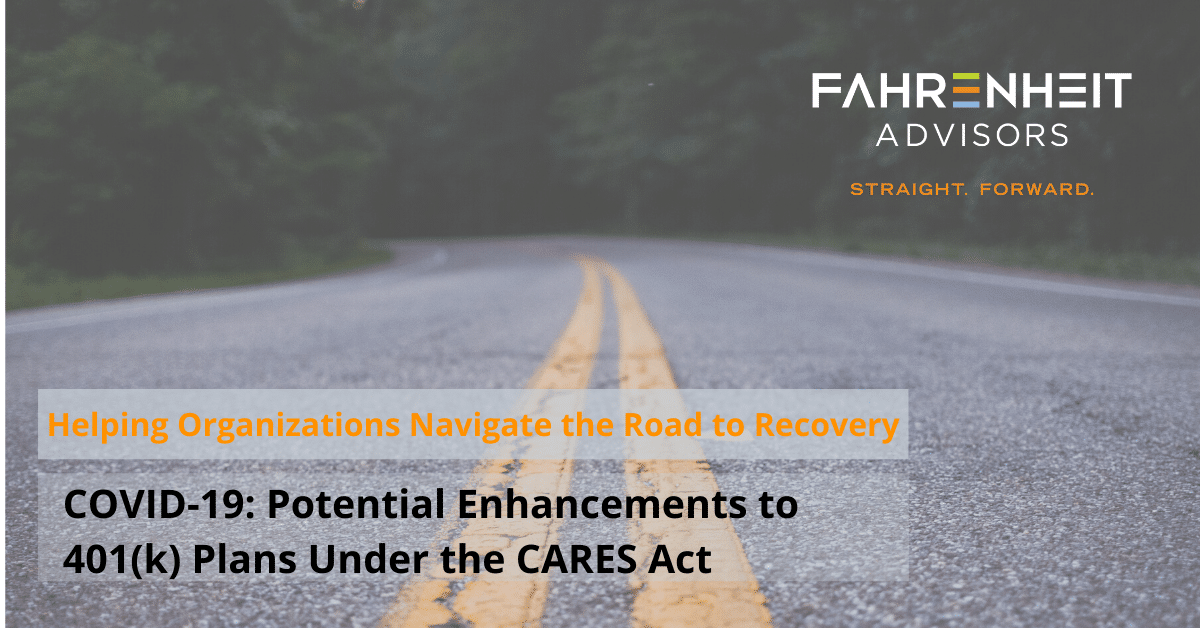COVID-19: 3 Enhancements to 401(k) Plans under the CARES Act

When the CARES Act was passed on March 27, 2020, several provisions applied to company 401(k) plans and haven’t received much attention. These changes apply to tax-qualified plans, such at 401(k) plans, 403(a) plans, and governmental 457(b) plans.
Summary of Changes
- Employers may allow participants to take in-service distributions of up to $100,000 if they have been impacted by COVID-19. No 10% tax penalty is assessed for early distributions.
- Employers that already allowed loans from the plan may increase the loan amount and extend the repayment period if the participant has been impacted by COVID-19.
- Required Minimum Distributions are waived for 2020.
1) COVID-19 Related Distributions
An in-service distribution may be taken for up to $100,000 without paying the 10% penalty tax for early distributions for eligible participants impacted by COVID-19. These distributions must be made between Jan 1, 2020 and Dec 31, 2020. Additionally, the 20% tax withholding is not required. To be eligible, one of the following must apply:
- Participant is diagnosed with COVID-19
- Participant’s spouse or dependent is diagnosed with COVID-19, or
- Participant experiences adverse financial consequences as a result of:
- Being quarantined, furloughed or laid off or having work hours reduced due to COVID-19
- Being unable to work due to lack of child care due to COVID-19
- Closing or reduced hours of a business owned or operated by the participant due to COVID-19, or
- Experience other factors as determined by the Secretary of the Treasury Department.
The administrator of a qualified retirement plan may relay on an employee’s certification that the employee satisfies one of the above conditions.
The amount of the distribution is included proportionally in the participants taxable income over a three-year period, beginning with the year of distribution, unless the participant elects otherwise.
The distribution can be repaid in one or more installments during this period and does not have to be repaid in full. If repaid, the amount is treated like a rollover into a qualified plan, i.e. tax-free.
2) COVID-19 Related Loans
- If your retirement plan permits loans, the CARES Act allows you to increase the maximum loan amount and extend the repayment period for loans made between March 27, 2020 and September 23, 2020 to participants impacted by COVID-19, as described above.
- The maximum loan amount may not exceed the lesser of $100,000 (previously this was $50,000) or, the present value of the employees vested accrued benefit under the plan (previously limited to ½ of the present value).
- Loan repayment dates between March 27, 2020 and Dec 31, 2020 may be delayed for one year. When this delay applies, any subsequent repayments must also be adjusted to reflect the delay in the due date. The five-year limit is disregarded.
3) Required Minimum Distribution (RMD)
- Typically, participants who reach the age of 70 1/2 before Jan 1, 2020 would be required to start taking RMDs in 2020. The CARES Act waives the requirement to make these distributions during 2020.
- For participants who already were taking RMDs, they do not have to take a 2020 RMD.
- RMDs for 2021 are not waived, and participants will have to resume RMD payment for 2021.
What you need to do
If you want to enhance your tax-deferred plan, reach out to your retirement plan advisor to initiate the process. Later, you can create plan amendments to enact the changes. The deadline for amendments is not earlier than the last day of the first plan years beginning after Jan 1, 2022 (which is Dec 31, 2022 for calendar year plans).
 About the Author
About the Author
Cynthia Macturk is responsible for the accounting, information technology, facilities, human resources, and operations of Fahrenheit. In addition to managing the firm’s day-to-day functions, she provides technical and project support on advisory engagements. Her background includes developing and managing accounting departments, financial systems evaluations and implementations as well as international and mergers and acquisitions accounting roles